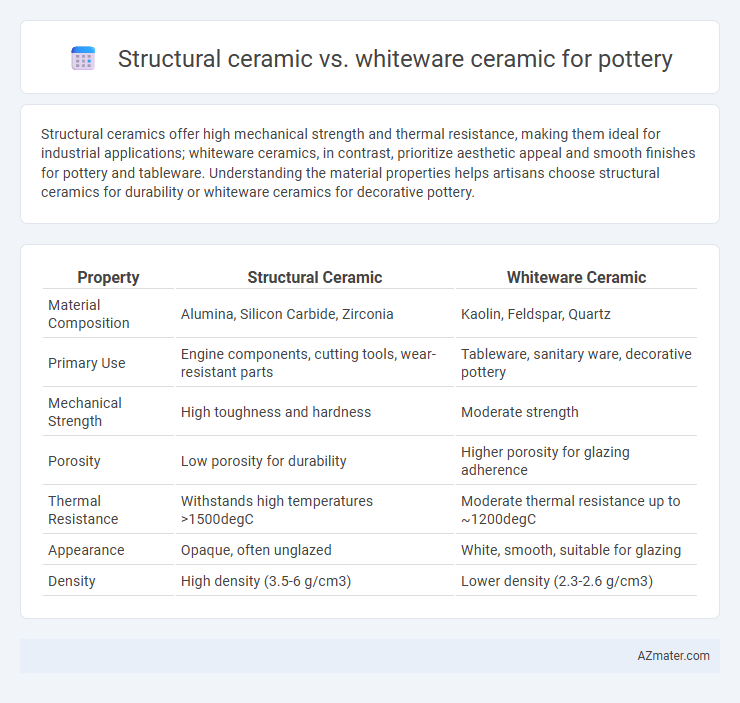Structural ceramics offer high mechanical strength and thermal resistance, making them ideal for industrial applications; whiteware ceramics, in contrast, prioritize aesthetic appeal and smooth finishes for pottery and tableware. Understanding the material properties helps artisans choose structural ceramics for durability or whiteware ceramics for decorative pottery.
Table of Comparison
| Property | Structural Ceramic | Whiteware Ceramic |
|---|---|---|
| Material Composition | Alumina, Silicon Carbide, Zirconia | Kaolin, Feldspar, Quartz |
| Primary Use | Engine components, cutting tools, wear-resistant parts | Tableware, sanitary ware, decorative pottery |
| Mechanical Strength | High toughness and hardness | Moderate strength |
| Porosity | Low porosity for durability | Higher porosity for glazing adherence |
| Thermal Resistance | Withstands high temperatures >1500degC | Moderate thermal resistance up to ~1200degC |
| Appearance | Opaque, often unglazed | White, smooth, suitable for glazing |
| Density | High density (3.5-6 g/cm3) | Lower density (2.3-2.6 g/cm3) |
Introduction to Structural and Whiteware Ceramics
Structural ceramics are engineered for high strength and durability, commonly used in applications requiring resistance to mechanical stress and high temperatures, such as in aerospace, automotive, and industrial components. Whiteware ceramics, including porcelain, earthenware, and stoneware, are primarily crafted for aesthetic and functional uses like tableware, tiles, and sanitary fixtures, characterized by their whiteness, translucency, and ability to be glazed. The fundamental difference lies in the material composition and firing processes, with structural ceramics emphasizing performance and toughness, whereas whiteware focuses on appearance and surface finish.
Defining Structural Ceramics in Pottery
Structural ceramics in pottery refer to materials engineered for high strength, durability, and resistance to mechanical stress, often used in load-bearing or functional components. These ceramics typically exhibit a dense microstructure and enhanced fracture toughness compared to whiteware ceramics, which prioritize aesthetic qualities like whiteness and glazeability for tableware and decorative items. Structural ceramics are designed to withstand thermal shock and physical wear, making them suitable for industrial or heavy-use applications within ceramic craftsmanship.
Overview of Whiteware Ceramics
Whiteware ceramics, characterized by their high alumina and silica content, are known for their bright, white appearance and fine texture, making them ideal for decorative pottery and tableware. Unlike structural ceramics, which prioritize strength and durability for industrial applications, whiteware ceramics emphasize aesthetic qualities and translucency. Their low porosity and high firing temperatures contribute to their smooth, non-porous surfaces, enhancing both functionality and visual appeal in pottery.
Raw Material Differences Between Structural and Whiteware Ceramics
Structural ceramics predominantly use dense, high-purity alumina and silicon carbide as raw materials to achieve superior mechanical strength and thermal resistance. Whiteware ceramics rely on kaolin, feldspar, and quartz, providing a smooth, white, and often translucent finish suited for tableware and decorative items. The raw material composition directly influences the physical properties, with structural ceramics optimized for durability and whiteware ceramics designed for aesthetic appeal and fine detailing.
Manufacturing Processes: Structural vs. Whiteware
Structural ceramics for pottery involve manufacturing processes such as dry pressing and isostatic pressing, which enhance mechanical strength and density by reducing porosity. Whiteware ceramics undergo slip casting or jiggering techniques, focusing on achieving a smooth, whitened surface ideal for decorative and functional tableware. These distinct processes reflect the differing functional priorities: structural ceramics emphasize durability and load-bearing capacity, while whiteware prioritizes aesthetic appeal and surface finish.
Physical and Mechanical Properties Comparison
Structural ceramics exhibit high mechanical strength, excellent hardness, and superior fracture toughness, making them suitable for load-bearing and wear-resistant applications. Whiteware ceramics, typically used in pottery and tableware, have lower mechanical strength and hardness but offer better thermal shock resistance and aesthetic qualities. The density of structural ceramics is generally higher, contributing to their durability, whereas whiteware ceramics emphasize translucency and smooth glaze finish.
Aesthetic and Functional Applications in Pottery
Structural ceramics exhibit superior mechanical strength and high thermal resistance, making them ideal for functional pottery like cookware and industrial-grade vessels. Whiteware ceramics, prized for their fine grain and smooth, white surface, offer exceptional aesthetic appeal suitable for decorative pottery and intricate glaze work. Both materials balance form and function, with structural ceramics prioritizing durability and whiteware ceramics emphasizing refined appearance and detail.
Durability and Performance in Practical Use
Structural ceramics exhibit superior durability and mechanical strength compared to whiteware ceramics, making them ideal for high-stress applications such as industrial components and advanced pottery. Whiteware ceramics, commonly used in tableware and decorative pottery, offer good aesthetic qualities but generally have lower resistance to impact and thermal shock. The enhanced performance of structural ceramics in practical use is attributed to their dense microstructure and higher fracture toughness, which significantly extend their lifespan under demanding conditions.
Cost and Market Considerations
Structural ceramics typically have higher production costs than whiteware ceramics due to the use of advanced raw materials and specialized manufacturing processes, which influence pricing in industrial markets. Whiteware ceramics dominate the consumer pottery market because they offer lower material and firing costs, making them more affordable for everyday use items like dinnerware and decorative objects. Market demand for structural ceramics is concentrated in technical and engineering sectors, while whiteware ceramics benefit from broader retail distribution and household applications.
Choosing the Right Ceramic Type for Your Pottery Project
Structural ceramics provide superior strength and thermal resistance, making them ideal for functional pottery that requires durability and heat tolerance, such as cookware or industrial components. Whiteware ceramics, characterized by their fine, white, and often glossy finish, suit decorative pottery and tableware where aesthetic appeal and smooth glazing are priorities. Selecting between structural and whiteware ceramics depends on the balance between mechanical performance needs and the desired visual quality for your pottery project.

Infographic: Structural ceramic vs Whiteware ceramic for Pottery
 azmater.com
azmater.com